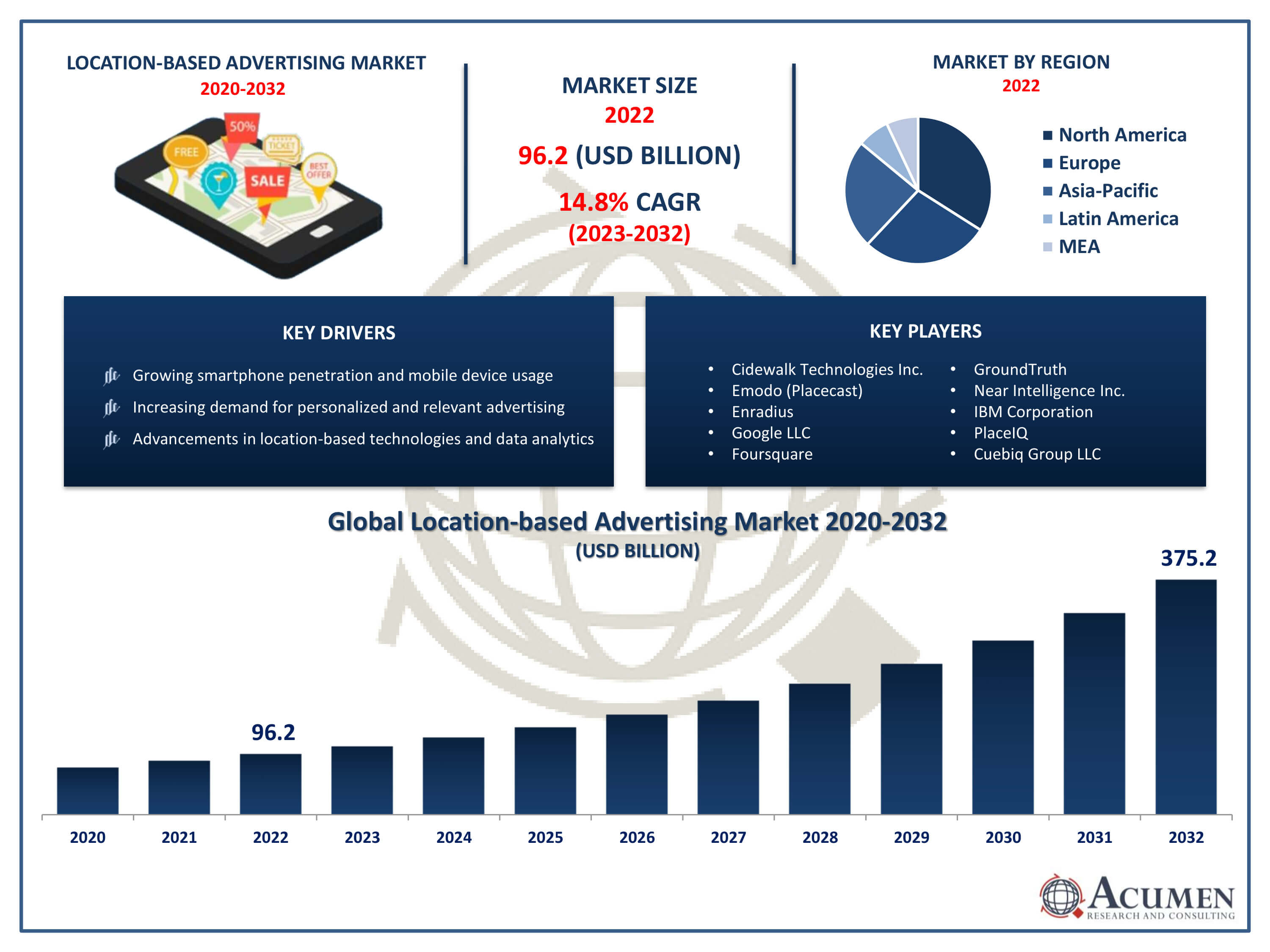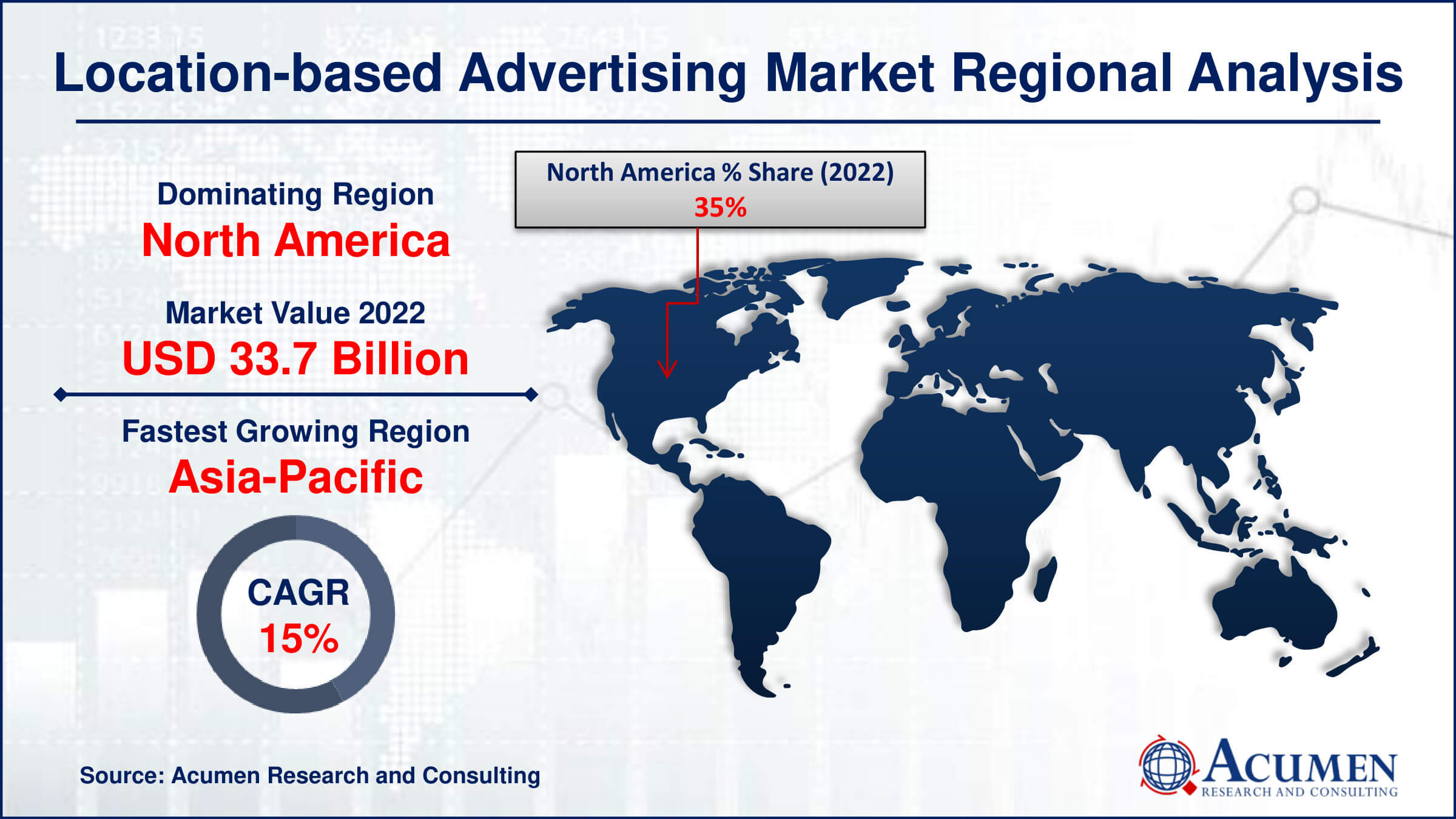December 2025
Location-based Advertising Market Size accounted for USD 96.2 Billion in 2022 and is projected to achieve a market size of USD 375.2 Billion by 2032 growing at a CAGR of 14.8% from 2023 to 2032.
The Location-based Advertising Market Size accounted for USD 96.2 Billion in 2022 and is projected to achieve a market size of USD 375.2 Billion by 2032 growing at a CAGR of 14.8% from 2023 to 2032.
Location-based Advertising Market Key Highlights

Location-based advertising (LBA) is a marketing strategy that utilizes the geographical location of a user to deliver targeted and relevant advertisements. This form of advertising leverages the GPS capabilities of mobile devices to deliver personalized content based on the user's current location. By understanding a user's whereabouts, advertisers can tailor their messages to be contextually relevant, promoting products or services that are geographically nearby or related to the user's specific location.
The market for location-based advertising has experienced significant growth in recent years due to the widespread adoption of smartphones and the increasing availability of location-based services. With the prevalence of mobile apps and the integration of location data into advertising platforms, businesses can reach consumers with highly targeted messages, driving engagement and potentially increasing conversion rates. As consumers increasingly rely on their mobile devices for various activities, advertisers recognize the potential of location-based advertising to enhance the effectiveness of their campaigns. This trend is expected to continue, and the market is likely to see further growth as technology advances and businesses continue to explore innovative ways to connect with their target audiences based on their physical location.
Global Location-based Advertising Market Trends
Market Drivers
Market Restraints
Market Opportunities
Location-based Advertising Market Report Coverage
| Market | Location-based Advertising Market |
| Location-based Advertising Market Size 2022 | USD 96.2 Billion |
| Location-based Advertising Market Forecast 2032 | USD 375.2 Billion |
| Location-based Advertising Market CAGR During 2023 - 2032 | 14.8% |
| Location-based Advertising Market Analysis Period | 2020 - 2032 |
| Location-based Advertising Market Base Year |
2022 |
| Location-based Advertising Market Forecast Data | 2023 - 2032 |
| Segments Covered | By Component, By Promotion Type, By Advertisement Type, By Application, By Industry Vertical, And By Geography |
| Regional Scope | North America, Europe, Asia Pacific, Latin America, and Middle East & Africa |
| Key Companies Profiled | Cidewalk Technologies Inc., Emodo (Placecast), Enradius, Facebook (Meta Platforms Inc.), Google LLC, Foursquare, GroundTruth, Near Intelligence Inc., IBM Corporation, PlaceIQ, Cuebiq Group LLC, and Yelp Inc. |
| Report Coverage |
Market Trends, Drivers, Restraints, Competitive Analysis, Player Profiling, Covid-19 Analysis, Regulation Analysis |
Location-based advertising (LBA) relies on technologies such as GPS, Wi-Fi, and beacons to track the location of mobile devices, enabling advertisers to tailor their messages based on the real-time physical context of users. This form of advertising is particularly effective in reaching consumers when they are in proximity to a specific business or location, allowing advertisers to deliver timely and location-specific promotions, offers, and information. The applications of location-based advertising are diverse and span various industries. Retailers, for instance, can use LBA to send targeted promotions to shoppers when they are near a physical store, encouraging them to make in-store purchases. In the hospitality sector, businesses can utilize LBA to send special offers to travelers as they arrive in a new city. Additionally, LBA is employed in the context of mobile apps, where advertisers can deliver location-specific content to users based on their movements and preferences, enhancing the overall user experience.
The location-based advertising market has witnessed robust growth in recent years, driven by the increasing prevalence of mobile devices and advancements in location-based technologies. The proliferation of smartphones has empowered advertisers to leverage users' real-time geographical data for delivering targeted and contextually relevant advertisements. This form of advertising allows businesses to reach consumers with messages tailored to their specific location, fostering a more personalized and engaging experience. The market growth is further fueled by the rising demand for effective and efficient advertising strategies. Location-based advertising enables businesses to optimize their campaigns by reaching consumers at the right place and time, thereby maximizing the impact of their marketing efforts. As technology continues to evolve, with improvements in location accuracy and data analytics capabilities, the market is poised for sustained growth.
Location-based Advertising Market Segmentation
The global Location-based Advertising Market segmentation is based on component, promotion type, advertisement type, application, industry vertical, and geography.
Location-based Advertising Market By Component
According to location-based advertising industry analysis, the geofencing segment held the largest market share in 2022. Geofencing involves creating virtual perimeters or boundaries around specific geographic locations, allowing businesses to send targeted messages or push notifications to users when they enter or exit these predefined areas. This technology has gained traction across various industries, including retail, hospitality, and events, as it enables precise and location-specific engagement with consumers. One key driver of the growth in the geofencing segment is the increasing demand for hyper-localized and personalized marketing strategies. Businesses can use geofencing to deliver highly relevant promotions, discounts, or information to consumers based on their immediate proximity to a store or venue.
Location-based Advertising Market By Promotion Type
In terms of promotion type, the search result promotion segment is dominate the market in 2022. This growth is driven by the increasing reliance on search engines and the desire for more relevant and localized search results. As consumers increasingly use search engines to discover local businesses and services, businesses are capitalizing on this trend by promoting their offerings through targeted search result advertising. By optimizing search results based on a user's location, advertisers can ensure that their products or services are prominently featured when users search for relevant terms in specific geographic areas. One of the key factors contributing to the growth of this segment is the effectiveness of search result promotion in connecting businesses with local consumers actively seeking products or services in their vicinity.
Location-based Advertising Market By Advertisement Type
According to the location-based advertising market forecast, the push advertising segment is expected to witness significant growth in the coming years. Push advertising involves sending promotional messages, notifications, or alerts to users' smartphones when they enter specific geographic areas or meet predefined criteria. This approach allows advertisers to proactively engage with consumers in a timely and location-relevant manner, capturing their attention and encouraging immediate action. The growth of push advertising can be attributed to the ubiquity of smartphones and the prevalence of mobile apps. As users willingly opt-in to receive push notifications from their favorite apps, advertisers can leverage this permission to deliver personalized and location-specific content. This form of advertising is particularly effective for promoting time-sensitive offers, special promotions, or events, enhancing the overall user experience by providing relevant information at the right moment.
Location-based Advertising Market By Application
Based on the application, the public spaces segment is expected to witness significant growth in the coming years. This growth is driven by the increasing integration of technology in urban environments and the desire to engage consumers in high-traffic areas. Public spaces, such as malls, airports, transit stations, and city centers, serve as strategic locations for advertisers to connect with a diverse and captive audience. The proliferation of digital signage, interactive displays, and beacon technology in these spaces has paved the way for innovative location-based advertising campaigns that leverage the foot traffic and dwell time of consumers. The growth in the public spaces segment is fueled by the effectiveness of location-based advertising in enhancing the overall consumer experience in these environments.
Location-based Advertising Market By Industry Vertical
In terms of industry verticals, the retail segment has been experiencing significant growth in recent years. Retailers are leveraging location-based advertising to connect with consumers in and around their physical stores, enhancing engagement and driving foot traffic. Through technologies such as geofencing and beacon systems, retailers can send targeted promotions, discounts, and personalized recommendations to shoppers' mobile devices based on their real-time location within or near a store. One of the key factors contributing to the growth of location-based advertising in the retail sector is the ability to bridge the gap between online and offline shopping experiences. By understanding a shopper's location and preferences, retailers can deliver tailored messages that guide consumers to relevant products, promotions, or in-store events.
Location-based Advertising Market Regional Outlook
North America
Europe
Asia-Pacific
Latin America
The Middle East & Africa

Location-based Advertising Market Regional Analysis
North America dominates the location-based advertising market for several reasons, primarily driven by the region's high smartphone penetration, advanced technological infrastructure, and widespread adoption of location-based services. The United States and Canada, in particular, have witnessed significant growth in mobile device usage, providing a vast user base for location-based advertising campaigns. The region's tech-savvy population and their willingness to engage with mobile apps make it an ideal market for advertisers seeking to leverage location data for targeted promotions. Moreover, North America hosts numerous tech giants and advertising platforms that play a pivotal role in shaping the landscape of location-based advertising. Companies like Google, Facebook, and other major players have developed sophisticated advertising algorithms that utilize location data to deliver highly targeted and personalized content to users. The competitive environment and continuous innovation within the North American tech industry further contribute to the region's dominance in this market.
Location-based Advertising Market Player
Some of the top location-based advertising market companies offered in the professional report include Cidewalk Technologies Inc., Emodo (Placecast), Enradius, Facebook (Meta Platforms Inc.), Google LLC, Foursquare, GroundTruth, Near Intelligence Inc., IBM Corporation, PlaceIQ, Cuebiq Group LLC, and Yelp Inc.
Looking for discounts, bulk pricing, or custom solutions? Contact us today at sales@acumenresearchandconsulting.com
December 2025
September 2024
November 2025
November 2023